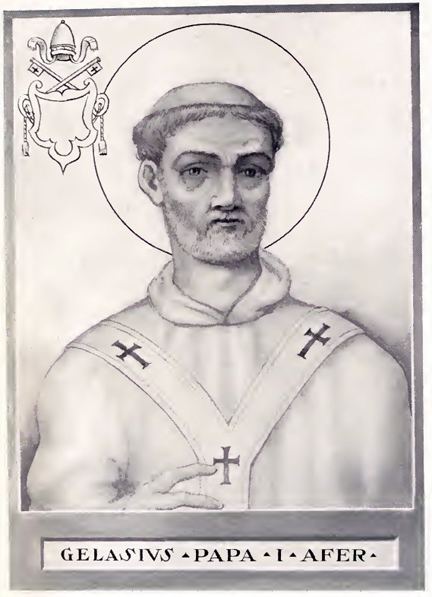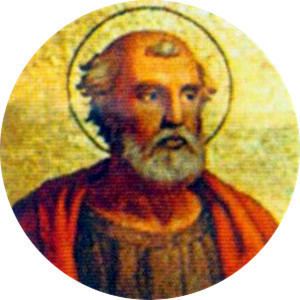Papacy began 1 March 492 Name Pope I Term ended November 19, 496 AD Feast day 21 November Posthumous style Saint | Birth name Gelasius Papacy ended 19 November 496 | |
 | ||
Similar People Pope Felix III, Pope Anastasius I, Pope Sixtus III, Pope Innocent I, Pope Celestine I | ||
Pope gelasius i
Pope Gelasius I (died 19 November 496) was Pope from 1 March 492 to his death in 496. He was probably the third and last Bishop of Rome of Berber descent in the Catholic Church. Gelasius was a prolific writer whose style placed him on the cusp between Late Antiquity and the Early Middle Ages. Gelasius had been closely employed by his predecessor Felix III, especially in drafting papal documents. His ministry was characterized by a call for strict orthodoxy, a more assertive push for papal authority, and increasing tension between the churches in the West and the East.
Contents
- Pope gelasius i
- Pagan origins of st valentines day pope gelasius i
- Place of birth
- Acacian schism
- Supercession of the Lupercalia
- Death
- Writings
- Decretum Gelasianum
- Gelasian Sacramentary
- Literature
- References

Pagan origins of st valentines day pope gelasius i
Place of birth
There is some dispute regarding where Gelasius was born: according to the Liber Pontificalis he was born in Africa (natione Afer), while in a letter addressed to the Roman Emperor Anastasius he called himself "born a Roman" (Romanus natus). The latter assertion probably just means that he was born in Roman Africa before it was overrun by the Vandals.
Acacian schism

Gelasius' election on 1 March 492 was a gesture for continuity: Gelasius inherited Felix's struggles with Eastern Roman Emperor Anastasius and the patriarch of Constantinople and exacerbated them by insisting on the removal of the name of the late Acacius, patriarch of Constantinople, from the diptychs, in spite of every ecumenical gesture by the current, otherwise quite orthodox patriarch Euphemius (q.v. for details of the Acacian schism).

The split with the emperor and the patriarch of Constantinople was inevitable, from the western point of view, because they had embraced a view of a single, Divine ("Monophysite") nature of Christ, which was a Christian heresy according to the Church of Rome. Gelasius' book De duabus in Christo naturis ("On the dual nature of Christ") delineated the Western view. Thus Gelasius, for all the conservative Latinity of his writing style, stood on the cusp of Late Antiquity and the Early Middle Ages.

During the Acacian schism, Gelasius affirmed the primacy of Rome over the entire Church, East and West, and he presented this doctrine in terms that set the model for subsequent popes asserting the claims of papal supremacy, due to the succession of the Roman Popes from the Apostle Peter.

In 494, Gelasius wrote a very influential letter, known as Duo sunt, to Anastasius on the topic of Church-State relations, whose political impact was felt for almost a millennium.
Supercession of the Lupercalia
Closer to home, Gelasius after a long contest finally suppressed the ancient Roman festival of the Lupercalia, which had persisted for several generations among a nominally Christian population. Gelasius' letter to Andromachus, the senator, covers the main lines of the controversy and incidentally offers some details of this festival combining fertility and purification that might have been lost otherwise. Significantly, this festival of purification, which had given its name— dies februatus, from februare, "to purify"— to the month of February, was replaced with a Christian festival celebrating the purification of the Virgin Mary instead: Candlemas, observed forty days after Christmas, on 2 February.
Death
After a brief but dynamic ministry, he died on 19 November 496. His feast day is kept on 21 November, the anniversary of his interment, not his death.
Writings
Gelasius was the most prolific writer of the early Roman bishops. A great mass of correspondence of Gelasius has survived: forty-two letters according to the Catholic Encyclopedia, thirty-seven according to Father Bagan and fragments of forty-nine others, carefully archived in the Vatican, expounding to Eastern bishops the primacy of the see of Rome. Additionally, there are extant six treatises that carry the name of Gelasius. According to Cassiodorus, the reputation of Gelasius attracted to his name other works not by him.
Decretum Gelasianum
The most famous of pseudo-Gelasian works is the list de libris recipiendis et non recipiendis (lit., "on books to be received and not to be received"), the so-called Decretum Gelasianum, which is believed to be connected to the pressures for orthodoxy during his pontificate and intended to be read as a decretal by Gelasius on the canonical and apocryphal books, which internal evidence reveals to be of later date. Thus the fixing of the canon of scripture has traditionally been attributed to Gelasius.
Gelasian Sacramentary
In the Latin Catholic tradition, the so-called Gelasian Sacramentary, is in fact a liturgical book derived from Roman resources and transcribed, with inclusion of native Gallican liturgical elements, near Paris in the middle of the 8th century. While containing some prayer texts composed by Gelasius, it does not have him as a principal author or organizer. The manuscript (Vatican, Vatican Library, Reg. lat. 316 + Paris, National Library, ms. lat. 7193, fol. 41-56) is actually titled the Liber sacramentorum Romanae ecclesiae ("Book of Sacraments / Mysteries of the Roman Church"). The attribution to Gelasius is based in part at least on the chronicle of the Popes known as the Liber Pontificalis, which says of Gelasius that he 'fecit etiam et sacramentorum praefationes et orationes cauto sermone et epistulas fidei delimato sermone multas', that is, 'he also made prefaces to the sacraments and prayers in careful language and many epistles in polished language regarding the faith' (Translation based upon Louise Ropes Loomis, The Book of the Popes (Liber pontificalis) I, Columbia University Press, New York, 1916, pp. 110-114). An old tradition linked the book to Pope Gelasius, apparently based on Walafrid Strabo's ascription to him of what is evidently this book.
Literature
The main source for the life of Gelasius, aside from Liber Pontificalis, is a vita written by Cassiodorus' pupil Dionysius Exiguus.
